Physical Address
23,24,25 & 26, 2nd Floor, Software Technology Park India, Opp: Garware Stadium,MIDC, Chikalthana, Aurangabad, Maharashtra – 431001 India
Physical Address
23,24,25 & 26, 2nd Floor, Software Technology Park India, Opp: Garware Stadium,MIDC, Chikalthana, Aurangabad, Maharashtra – 431001 India

On August 9, 2022, the Lok Sabha passed the Energy Conservation (Amendment) Bill 2022 to amend the Energy Conservation Act 2001. The Bill is being termed as a facilitator for India to achieve its climate targets. Apart from various other amendments like mandatory utilization of non-fossil sources of energy and the introduction of an energy conservation code for large buildings, the Bill talks about the introduction of Carbon Markets in India.
What is a Carbon Market?
We know that rapid industrial growth has led to the accumulation of huge amounts of carbon in the atmosphere. This is leading to global warming and climate change is already being experienced worldwide. It is now widely accepted by scientists worldwide that the situation will only get worse unless some form of a solution in the form of reduced carbon emissions is not sought globally and urgently.
Setting a price for carbon emissions or carbon pricing has been considered by various countries of the world as an optimal strategy to bring down emissions. This led to the introduction of the ‘Carbon Market’ concept and the origin of it all is believed to be the Kyoto Protocol in 1997. This international meet established carbon as an internationally tradable commodity when developed countries were mandated to be operating carbon markets. However, later during the Paris Agreement, it was made voluntary for countries.
ScienceDirect defines a carbon market as, “The carbon market is a very important tool to provide one of the flexibility mechanisms which intend to economically reduce CO2 emissions toward the solution of the global warming problem.”
In simple words, carbon markets are trading systems in which carbon credits are sold and bought and one tradable carbon credit is equal to one tonne of carbon dioxide gas reduced, sequestered or avoided.
An industrial unit that outperforms the emission standards gains credits which can be sold in the carbon market and can be bought by other units struggling to attain standards for compliance. Thus ultimately the carbon market creates incentives to reduce emissions or improve energy efficiency.
Types of Carbon Markets
There are mainly two types of carbon markets: compliance markets and voluntary markets.
Compliance markets are also known as mandatory markets and are normally set up by the government or a regulating body to target specific industries or sources that emit GHGs. In this system, the government typically places ‘caps’ on GHG emissions and the industry or the emitter is mandated to offset their emissions as part of a nation’s obligation to cut their emission, normally for some international accord or agreement. The emitter obtains pollution permits or allowances and industries with low emissions can sell their extra ‘allowances’ to larger emitters.
Voluntary markets are mostly set up by private companies to facilitate transactions of carbon offsets. They are incentive-based markets allowing private entities to purchase carbon offsets on a voluntary basis.
Carbon Pricing
‘Carbon pricing is an instrument that captures the external costs of greenhouse gas (GHG) emissions—the costs of emissions that the public pays for, such as damage to crops, health care costs from heat waves and droughts, and loss of property from flooding and sea level rise—and ties them to their sources through a price, usually in the form of a price on the carbon dioxide (CO2) emitted,’ according to the World Bank.
Two main types of carbon pricing are emissions trading systems (ETS) and carbon taxes which are based on compliance markets.
According to a recent report, there are about 37 carbon taxes and 34 emissions trading systems (ETS) in the world covering about 23% of global GHG emissions.
ETS or ‘cap-and-trade system’ caps the total level of greenhouse gas emissions and allows industries with low emissions to sell their extra allowances to larger emitters. The ETS establishes a market price for greenhouse gas emissions by creating supply and demand for emissions allowances. On the other hand, the ‘cap’ ensures that the emitters stay within their pre-allocated carbon budget.
A carbon Tax mechanism directly sets a price on carbon by fixing a tax rate on greenhouse gas emissions or on the carbon content of fossil fuels.
Indian Context
As per the updated NDC, India has recently declared that it is committed to reducing the emissions intensity of its GDP by 45 percent by 2030, from 2005 level, and achieving about 50 percent cumulative electric power installed capacity from non-fossil fuel-based energy resources by 2030.
Thus in line with the updated NDC, the Energy Conservation (Amendment) Bill 2022 makes a certain percentage of minimum utilization of non-fossil sources of energy mandatory for end users including the industrial sector, transport sector and commercial buildings. Non-adherence to the obligation for utilization of non-fossil sources of energy will attract a fine of up to Rs 10 lakh, as per the new rules.
According to the bill, the central government or any other authorized agency in India will now be able to grant ‘carbon credit certificates’ to a registered entity. These credits can then be further traded in a market system.
Although this will be India’s first carbon market, the Bureau of Energy Efficiency (BEE) set up under the Energy Conservation Act 2001 had started a similar scheme known as Perform Achieve and Trade (PAT). PAT consists of offering incentives to industries for energy efficiency and even allows the trading of excess energy saved.